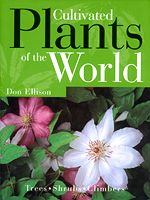
|
Cultivated
Plants of the World By Don Ellison Reviewed by Gordon Collier Don Ellison's eagerly
awaited pictorial dictionary of cultivated plants of the world is
a work of heroic proportions. Its 598 pages are beautifully designed
and bound, a significant new corner to a world already well endowed
with books. The title proclaims a publication of unusual scope.
How could so much be encompassed between two covers? The short answer
is, it can't. It is not at once apparent that angiosperms (flowering
plants) only are covered, gymnosperms including conifers, are excluded. The author is Australian,
a Brisbane based horticulturist with a lifetime's experience in
nursery work, both selling and propagating and who latterly operated
a seed production business. Ellison has also been active in radio
and has written about gardening over a long period. Herein lie the
clues to the context of this plant dictionary. Beginning with brief
notes on plant classification and nomenclature, the author moves
on to cover planting distances, climate and soil, propagation and
plant selection. This information is basic but will be helpful to
many. Ellison is in deep water when discussing plant classification.
He writes "true breeding hybrids are given species style names with
the addition of the × sign. For example Daphne ×burkwoodii".
It is my understanding that the × sign denotes a hybrid between
two species, in this instance between Daphne caucasica and
D. cneorum. The progeny of this cross do not breed true. On casual inspection
this dictionary is all it promises. Clearly printed on glossy paper,
the photographs, up to 10 per page, are of sufficient size to make
identification of a vast range of plants possible. Mostly close-ups
of flowers and foliage, the images are sharp and the colour accurate.
Approximately 5,000 plants are reproduced in the 566 pages of pictorial
reference. An excellent index concludes along with indexes of common
names and synonyms. A helpful feature through the book is a coloured
margin which contains guide reference information. Clearly this
is value for money. "Cultivated Plants of
the World" will become a standard reference in Australia. The question
must be asked, Will it be equally valued by New Zealanders? It would
be easy to allow one's judgement to be clouded by its magnitude
and scope, by the multitude of wonderful photographs and by the
enormous effort of author and photographer alike. Further scrutiny
shows however, that from a New Zealander's viewpoint there is not
only an imbalance in the plant selection process between warm and
cool climates, there is also a clear bias towards Australian and
to 'nursery' plants, that is, plants with showy flowers and/or foliage.
For instance there are 42 illustrations of Callistemon, 80 of Grevillea,
87 of Hibiscus, 84 of Bougainvillea, 40 of Melaleuca, 39 of Banksia
and 24 of Poinsettia (Euphobia pulcherrima), while there
are only 9 of Quercus, 4 of Betula and none of either Tilia or Nyssa.
Rhododendron is represented by 45 photographs, 9 of which are species
and there are an additional 50 pictures of rhododendrons belonging
to the vireya section. Most of these are hybrids unfamiliar to New
Zealanders and there are no species. Don Ellison has travelled
extensively photographing plants. He has yet to visit New Zealand.
Readers will smile at the cordyline on p. 178 which is clearly not
C. indivisa yet marvel at the dazzling variety of C.
terminalis available in Australia. Understandably few of our
native plants have been selected and puriri has become pururi. There
are few errors otherwise. A number of plants dear to New Zealand gardeners are missing: Magnolia 'Iolanthe', Photinia 'Red Robin', Azara microphylla, Cornus 'Eddie's White Wonder' spring to mind. Few gardens here are without Lavatera 'Barnsley' and Rhododendron yakushimanum, both of which are world wide favorites. Meanwhile be content with such unfamiliar plants as Acokanthera, Acrocarpus, Aeschynanthus, Afgekia, and Anthotroche, not forgetting Tetratheca, Theobroma, Thespesia and Theretia. This is a book for the plantaholic. New
Zealand Garden Journal: Journal of the Royal New Zealand Institute
of Horticulture 1996 1(1): 26 |
Home | Journal
| Newsletter | Conferences
Awards | Join
RNZIH | RNZIH Directory | Links
© 2000–2025 Royal New Zealand Institute of Horticulture
Last updated: March 1, 2021

 BOOK
REVIEWS
BOOK
REVIEWS